Avian Flu in Dairy Cows and Domesticated Cats: A New Threat
By: Dreama Thomas
Overview: Avian flu, also known as Highly Pathogenic Avian Influenza (HPAI), has recently been detected in dairy cows and domesticated cats. This marks a significant development in the spread of the virus, which was previously confined to birds and poultry.
Recent Feline Cases: Wisconsin: One confirmed fatal case. Los Angeles: Declared a State of Emergency due to the disease spreading to a quarter of the state’s dairy farms in the last month. There have been ten confirmed cases in cats.
Causes: The virus is primarily transmitted through: Ingestion of or exposure to wild birds. Consumption of contaminated raw bird meat. Drinking raw milk.
Survival Rate: Currently, the survival rate for infected dairy cows and cats is zero.
Clinical Signs: The clinical signs of Avian Flu in affected animals are similar to those of upper respiratory infections and rabies. These include: Respiratory Signs: Sneezing, coughing, and nasal discharge. Neurological Signs: Circling, tremors, and seizures.
Transmission: To Humans: As of now, there have been no reported cases of transmission from cats to humans. Between Animals: The virus spreads rapidly among animals, and by the time clinical signs are evident, it is often too late to isolate the infected animal.
Reportable Disease: Avian Flu is classified as a reportable disease, meaning that any suspected cases must be reported to the appropriate health authorities immediately.
Prevention and Control: Avoid feeding animals raw or undercooked meat and unpasteurized milk. Limit exposure to wild birds and contaminated environments. Implement strict biosecurity measures on farms and in households with pets.
Conclusion: The emergence of Avian Flu in dairy cows and domesticated cats is a serious concern. Immediate reporting and stringent preventive measures are crucial to control the spread of this deadly virus.
Updated Intake and Visitation Procedures for H5N1 Prevention
Purpose: To prevent the introduction and spread of Highly Pathogenic Avian Influenza (HPAI) H5N1 in our shelter, we are implementing updated intake and visitation procedures.
Intake Procedures: Initial Assessment- All incoming animals will undergo a thorough health assessment upon arrival. Animals showing signs of respiratory or neurological illness will be isolated immediately.
Quarantine: New arrivals will be quarantined for a minimum of 14 days. During quarantine, animals will be monitored closely for any signs of H5N1 infection, such as sneezing, coughing, circling, tremors, or seizures.
Testing: Animals suspected of having H5N1 will be tested promptly. Confirmed cases will be reported to the appropriate health authorities as H5N1 is a reportable disease.
Visitation Procedures: Restricted Access- Visitation will be limited to essential personnel only. Visitors must wear personal protective equipment (PPE) including masks, gloves, and gowns.
Hygiene Protocols: Hand sanitizing stations will be placed at all entry and exit points. Visitors and staff must sanitize their hands before and after contact with animals.
Disinfection: All areas of the shelter will be disinfected regularly, with special attention to high-contact surfaces. Equipment and tools used in animal care will be disinfected after each use.
Education and Training: Staff and volunteers will receive training on the signs of H5N1 and the importance of biosecurity measures. Informational materials about H5N1 and prevention strategies will be provided to all visitors.
Monitoring and Reporting: Continuous monitoring of animal health will be conducted. Any suspected cases of H5N1 will be reported immediately to the shelter management and relevant health authorities.
Conclusion: By updating our intake and visitation procedures, we aim to protect the health of our animals, staff, and visitors from the threat of H5N1. Your cooperation and adherence to these new protocols are essential in maintaining a safe environment for everyone.


